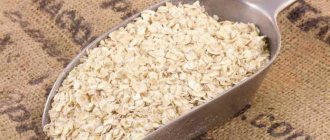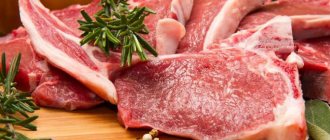Jellied meat is a very popular dish that every housewife prepares in her own way.
But is it possible to eat jellied meat while “on a diet”? Eating jelly while losing weight is allowed, moreover, it is healthy.
The main thing is to know how to cook it correctly and when to eat it.
There are many dietary recipes for jellied meat and aspic that speed up the process of losing weight and have a good effect on overall health.
What is jellied meat and how did it appear?
In essence, jellied meat is a transparent gelatinous jelly left after boiling a thick broth. The dish first appeared in the 14th century in France, where wealthy people could afford very rich meat soups. Initially, French chefs were skeptical about the taste of jelly, but over time, a dish called galantine was invented. To create it, processed meat was twisted into a jelly state, and then sent back to the broth and kept in the cold for some time.
Russian jellied meat appeared around the same time - although initially it was prepared from simple meat scraps. The tradition of seasoning jelly with spices and herbs arose later, and came precisely from Europe.
Jellied meat: benefits and harms
Charges with vitamins
Pork contains a large amount of zinc, iron, acids, and vitamin B12. The listed elements are components of red meat. They help the body fight ailments: avitaz, lack of iron and calcium.
Eliminates oxygen starvation
Myoglobin is the main component in pig meat; it helps oxygen actively move in the muscles. As a result, the risk of cardiovascular diseases is reduced.
The main assistant in the fight against male diseases
Nutrients in pig meat help prevent premature impotence, prostatitis, and infectious diseases of the male genitourinary system.
Lifts your mood and energizes your body
Don't forget to add lard or fat to the jellied meat. Pork fat helps cope with depression and loss of strength. Season the pork jellied meat with garlic and black pepper. With these seasonings it acquires antibacterial properties.
Tasty and harmless
Jellied meat with beef has a spicy aroma and tender meat. Unlike pork, beef contains a small amount of harmful substances.
It is customary to add mustard or horseradish to jellied meat with beef to give the dish a spicy note and increase antibacterial properties.
Well absorbed
The fat content of beef is 25%, and it is digestible by 75%. For diseases of the gastrointestinal tract, doctors allow eating beef.
Improves eye function
Beef jellied meat is useful for people suffering from eye diseases.
Beef jellied meat contains vitamin A (retinol), which is necessary for eye function. It helps prevent malignant changes in the retina and optic nerves. People with night blindness especially need this Vita.
Takes care of joints
Beef jellied meat contains a lot of animal protein, which is necessary for tissue repair. In 100 gr. Beef contains from 20 to 25%. Doctors and trainers advise athletes to include beef in their diet. Frequent heavy force loads on the spine and knee joints wear out the intervertebral discs and cartilage. The necessary supply of carotene, iron, and animal fat will help to avoid premature diseases. Beef jellied meat contains 50% of the entire stock.
If you go to the gym, eat beef jellied meat before training. Meat contains substances that increase physical activity.
Chicken legs for jellied meat are sold at any city market. The legs are ideal for jellied meat: chicken fillet has few calories, thighs have a lot of fat, and the gizzards and hearts have a different taste. Housewives rarely use paws in cooking; the paws look unpresentable. However, experienced chefs are confident that jellied chicken feet will bring many benefits.
Maintains the amount of vitamins and carbohydrates in the body
Chicken feet contain vitamin groups A, B, C, E, K, PP and macroelements: potassium, calcium, magnesium, iron, phosphorus. Chicken feet contain choline. Once in the body, it improves the metabolism of nerve tissues and normalizes metabolism.
Normalizes blood pressure
The broth in which the paws are cooked increases the pressure. Japanese scientists have found that chicken feet contain 19.5 g of antihypertensive protein. This amount is enough to combat high blood pressure.
Improves the functioning of the musculoskeletal system
Collagen in the paws has a positive effect on joint mobility and protects cartilage from damage. In kindergartens, sanatoriums and boarding houses, broth from chicken feet is served as a first course. In these age categories, joints are in a fragile state, so jellied meat will have a positive effect on health.
Pork jelly contains cholesterol and is not recommended for people suffering from atherosclerosis. A fatty dish is contraindicated for liver diseases and pancreatitis; it can provoke an exacerbation of the disease. Meat broth contains growth hormones; when they enter the body in large quantities, they can provoke an inflammatory process and lead to tissue hypertrophy.
Pork jelly contains a lot of hist, which often causes furunculosis and cholecystitis. Pork leg jellied meat contains 350 kcal per 100 g of product. People who are struggling with excess weight should eat chicken or turkey jellied meat.
Regular consumption of jellied meat has a positive effect on various organs and the entire body:
- strengthens bones, connective tissues, tendons and ligaments due to collagen;
- improves brain processes, fights depression due to glycine in its composition;
- strengthens the immune system, since retinol contained in meat successfully fights viruses and bacteria
For women, jellied meat is useful as a source of collagen, which is responsible for the elasticity and youth of the skin. Collagen is especially important after 40 years of age, when the body's ability to produce it decreases significantly with age.
Jellied meat helps pregnant women regulate hemoglobin levels in the blood. During breastfeeding, the vitamin and microelements contained in this product help the woman’s body maintain health.
Jellied meat is useful for men because it promotes the growth of muscle tissue. And pork jellied meat improves potency and helps prevent prostatitis.
The benefits and harms of jellied meat is a pressing question for everyone who likes to enjoy a gelatinous dish. It is interesting to understand what the product is made of and what properties it has.
In essence, jellied meat is a transparent gelatinous jelly left after boiling a thick broth. The dish first appeared in the 14th century in France, where wealthy people could afford very rich meat soups. Initially, French chefs were skeptical about the taste of jelly, but over time, a dish called galantine was invented. To create it, processed meat was twisted into a jelly state, and then sent back to the broth and kept in the cold for some time.
Russian jellied meat appeared around the same time - although initially it was prepared from simple meat scraps. The tradition of seasoning jelly with spices and herbs arose later, and came precisely from Europe.
Many people like the taste of jellied meat, but they value the product primarily for its beneficial properties. Namely, it contains:
- useful ral substances - copper, potassium, phosphorus;
- elements fluorine, sulfur, rubidium;
- Al and boron, calcium and vanadium;
- polyunsaturated fatty acids;
- collagen and glycine;
- gelatin;
- retinol;
- valuable aliphatic acid;
- vita - C, B9, A.
Even a small portion of high-quality jelly brings great benefits to the body.
Since jellied meat is made from different types of meat, the calorie content may vary.
- Pork jelly is the most nutritious - calorie content ranges from 340 to 390 calories per 100 g of product.
- In second place is beef jellied meat - it contains from 130 to 180 calories.
- The least calorie-rich jellied meat is made from lean poultry meat - turkey or chicken. It contains from 80 to 200 calories.
Pork jellied meat is recommended to be consumed only by very healthy people - for many ailments, a fatty dish will be harmful. The properties of jellies made from poultry and beef are considered the most dietary.
Meat jelly is not only nutritious, it has a pleasant taste and is beneficial for the body. Specific valuable properties depend on what meat the dish is prepared from. But there are several common qualities inherent in any jelly. Namely, the product has a positive effect:
- for immunity - retinol present in the dish successfully fights viruses and infections;
- on joints - gelatin in the product strengthens bone and connective tissue;
- on the nervous system - glycine in the jelly improves brain function and helps get rid of depression;
- on metabolic processes - in particular, the product’s properties are very effective for hangover syndrome.
Among the beneficial properties of the product, one valuable quality is especially noted - a positive effect on joints and connective tissues. The fact is that any jelly, especially beef, contains a high percentage of animal protein. It is protein that is largely responsible for the rapid restoration of tendons, cartilage, ligaments and bones.
Regular consumption of beef or pork jelly is highly recommended for athletes. During training, their joints are subjected to particularly heavy loads and are often injured. The protein, collagen and carotene in the product can protect bone tissue from destruction, and in addition, will further increase physical endurance.
Jellied meat has been known since ancient times; it gained popularity as a cold dish back in the 14th century. The basis of the culinary history of this dish comes from the rich houses of Europe. At that time, thick, rich soups were served for lunch, which, when cooled, turned into a viscous mass. Soups were cooked using broths made from bones and cartilage.
French chefs, having changed the recipe, prepared a dish from different types of meat, which was boiled for a long time, then chopped, filled with broth, and then cooled. This meat aspic is called galantine.
The Russian people came up with their own version of galantine - jelly. After the lordly feasts, all inedible delicacies were sent to a large cauldron, where they were boiled down to a mushy mass. Then it was left in a cool place to harden. Such food was no longer served to masters; it was fed to servants in order to save money. In the 16th century, fashion trends in France had a great influence.
Wealthy people invited foreign chefs to their kitchens. Chefs constantly improved the recipes by adding new ingredients. The taste of the dish improved significantly, which gave rise to including jellied dishes in the list of cold appetizers in rich homes.
Jellied meat became popular, later replacing gourmet meats and game with beef and pork offal, which has survived to this day. In the modern world, chicken, beef and pork meat are added to jellied meat; the broth is cooked from bones and legs with skin, which makes it possible to harden without using additional gelatin.
Polyunsaturated fatty acids:
- Collagen.
- Glycine.
- Gelatin.
- Valuable aliphatic acid.
Chemical composition of jellied meat
Many people like the taste of jellied meat, but they value the product primarily for its beneficial properties. Namely, it contains:
- useful minerals - copper, potassium, phosphorus;
- elements fluorine, sulfur, rubidium;
- aluminum and boron, calcium and vanadium;
- polyunsaturated fatty acids;
- collagen and glycine;
- gelatin;
- retinol;
- valuable aliphatic amino acid;
- vitamins - C, B9, A.
Even a small portion of high-quality jelly brings great benefits to the body.
How many calories are in jellied meat
Since jellied meat is made from different types of meat, the calorie content may vary.
- Pork jelly is the most nutritious - calorie content ranges from 340 to 390 calories per 100 g of product.
- In second place is beef jellied meat - it contains from 130 to 180 calories.
- The least calorie-rich jellied meat is made from lean poultry meat - turkey or chicken. It contains from 80 to 200 calories.
Pork jellied meat is recommended to be consumed only by very healthy people - for many ailments, a fatty dish will be harmful. The properties of jellies made from poultry and beef are considered the most dietary.
Nutritional value of the dish, calculation of calorie content and BJU
Usually, the name jellied meat refers to a strong broth of pork, which negatively affects the figure. However, jelly can be prepared from less high-calorie ingredients: chicken, turkey, beef, veal, etc.
There is no clear answer to the question of what the calorie content of aspic is. The energy value depends on the composition, as well as the cooking method.
The number of calories in 100 g of cold snacks from different components:
- Chicken is prepared from meat with low nutritional value (158-180 kcal), the calorie content of the broth is about 36 kcal. Therefore, chicken jelly contains approximately 110-150 kcal. This dish is suitable for diet.
- Beef is cooked from lean meat (about 180 kcal) and dietary broth (4 kcal/100 g). To further reduce the nutritional value of the aspic, you can use beef tongue (145 kcal/100 g). 100 g of beef cold appetizer contains from 80 to 130 kcal.
- Pork is prepared from fatty meat (legs, ears, tail, knuckle), the calorie content of which is about 260 kcal/100 g. The nutritional value of pork jelly is up to 350 kcal.
- Turkey jelly is prepared less frequently, but its taste and benefits are much higher than pork jellied meat. The caloric content of the aspic is 160 kcal.
In addition, you can prepare a cold appetizer from chicken feet (120 kcal) or thighs and paws (293 kcal). The nutritional value of aspic in a multicooker is only 103 kcal.
This is interesting! To reduce the number of calories in jellied meat, reduce the amount of meat in it and increase the amount of water.
During the diet, it is important to control the proportions of proteins, fats, carbohydrates (BJU) per 100 g of jelly:
- Pork: proteins – 7.5 g, fats – 6.6 g, carbohydrates – 0.7 g.
- Chicken: B – 15.2 g, F – 3.9 g, U – 0.7 g.
- Beef: B – 8.2 g, F – 5.1 g, U – 0.6 g.
- Turkey: B – 0.5 g, F – 0.2 g, U – 0.5 g.
As you can see, the nutritional value of turkey aspic is the lowest, so it is more suitable for a diet.
You may also be interested in:
Dietary barbecue on the grill
Is it possible to eat sausage while on a diet?
Be sure to check out:
Is it possible to eat corn while on a diet: benefits and harms? Get a complete set of proteins, fats and carbohydrates from Doshirak dietary products on a diet: is it possible to eat fast food products? Is it possible to eat soy sauce while on a diet: all the myths and truth
What are the health benefits of jellied meat?
Meat jelly is not only nutritious, it has a pleasant taste and is beneficial for the body. Specific valuable properties depend on what meat the dish is prepared from. But there are several common qualities inherent in any jelly. Namely, the product has a positive effect:
- for immunity - retinol present in the dish successfully fights viruses and infections;
- on joints - gelatin in the product strengthens bone and connective tissue;
- on the nervous system - glycine in the jelly improves brain function and helps get rid of depression;
- on metabolic processes - in particular, the product’s properties are very effective for hangover syndrome.
Calorie content of jellied meat (100 g)
| Meat for jellied meat | Calorie content of the dish |
| chicken | 115 kcal |
| beef | 92 kcal |
| chicken feet | 89 kcal |
| turkey meat | 85 kcal |
| pork | 180 kcal |
| pork feet | 380 kcal |
The calorie content of jellied meat directly depends on the meat used to prepare the broth.
Chicken and turkey meat will be less nutritious. Another dietary option for jelly will be veal-based jellied, only 92 kcal and mum of fat in a rich broth. Pork jellied meat is considered the most high-calorie, but also one of the healthiest. The chemical composition of jellied meat amazes with the variety of vitavs and rals. Alu, fluorine, boron, rubidium, vanadium are trace elements that make up jellied meat. Calcium, phosphorus and sulfur make up the main part of the macronutrients. The broth for jellied meat takes a long time to cook, but the beneficial substances are retained in it. The main vitamins in aspic are B9, C and A.
- Vitamin B group affects the formation of hemoglobin.
- Lysine (aliphatic acid) helps absorb calcium and fights viruses.
- Polyunsaturated fatty acids have a beneficial effect on the nervous system.
- Glycine promotes the activation of brain cells, reduces fatigue, and relieves irritation.
- Collagen slows down aging, makes the skin elastic, and removes toxins from the body. Collagen also provides strength and elasticity to muscle tissue, which is necessary for joints and ligaments. The properties of collagen protein can delay the process of abrasion of cartilage in joints.
- Gelatin improves joint function. During the cooking process, remember that the broth should not be overcooked. The protein in jellied meat is quickly destroyed during prolonged boiling.
Agree that jellied meat is a favorite snack on the holiday table. But remember that jellied meat is high in calories. In 100 gr. The product contains 250 kcal.
Don't forget what kind of meat the jellied meat is made from. If you prefer pork jellied meat, it contains 180 kcal per 100 g. product. Chicken - 120 kcal per 100 g. product.
For those who are on a diet, the option of jellied meat made from lean beef (80 kcal) or turkey (52 kcal) is suitable.
Try to eliminate store-bought food from your diet. Homemade natural jellied meat is a storehouse of vitamins.
The chemical composition and calorie content of jellied meat depend on what meat it is made from.
Common properties for all types of this dish are:
- polyunsaturated fatty acids;
- collagen;
- glycine;
- ral substances: potassium, phosphorus, sulfur, fluorine, copper, calcium and others;
- acids, among them aliphatic;
- vita groups A and B
The calorie content of a dish can vary from 340-390 kcal per 100 g of product if it is prepared from pork meat to 50-120 from turkey and chicken. 100 g of beef jellied meat contains from 130 to 180 kcal.
Jellied meat for treating joints
Among the beneficial properties of the product, one valuable quality is especially noted - a positive effect on joints and connective tissues. The fact is that any jelly, especially beef, contains a high percentage of animal protein. It is protein that is largely responsible for the rapid restoration of tendons, cartilage, ligaments and bones.
Regular consumption of beef or pork jelly is highly recommended for athletes. During training, their joints are subjected to particularly heavy loads and are often injured. The protein, collagen and carotene in the product can protect bone tissue from destruction, and in addition, will further increase physical endurance.
The benefits of pork jellied meat
The beneficial properties of a product made from pork knuckle, tail, ears or legs are dictated by the valuable qualities of the pork itself. In particular, it contains amino acids and iron, vitamin B12 and myoglobin, animal fat.
Pork jellied meat:
- effectively protects the body from vitamin deficiency;
- replenishes calcium reserves;
- has a beneficial effect on the condition of blood vessels and the heart.
Attention! The benefit of jellied pork legs for men is that the properties of the product serve as a prevention of prostatitis and improve potency.
The benefits of beef jellied meat
Jelly made from beef is less fatty than pork and is much better digestible, by as much as 76%. Therefore, you can use the product even with many gastrointestinal diseases; it will not cause harm.
Beef jelly contains a large amount of vitamin A, so it is extremely beneficial for eye health. The product contains carotene, which strengthens muscle, bone and connective tissues and promotes their recovery. The benefits of jellied beef legs will be especially great for athletes whose muscles and joints are subject to special stress.
What are the benefits of chicken jellied meat?
A product made from chicken or turkey meat is most useful for those who want to lose weight. The calorie content of jelly is very low, and it contains a lot of valuable substances. These are the main vitamins C, A, B, elements: iron and magnesium, calcium.
Choline in chicken or turkey jellied meat helps regulate metabolism and has a beneficial effect on the nervous system. The collagen present in the product has a good effect on hair and skin. This is also why the benefits of jellied chicken feet will be especially great for the fair sex.
How long to cook chicken jellied meat
To prepare delicious chicken jellied meat, it is better to use a whole soup chicken or soup cockerel or their parts - heads, legs, drumsticks, wings, heads. The ratio of meat and water is 1:2.
Soup chickens and cockerels take a long time to cook - 3-4 hours, and sometimes up to 5 hours. Depends on the age of the bird. When done, the meat separates from the bones and falls apart at the joints. The broth turns out very tasty and aromatic. You can check whether the jellied meat has frozen by wetting your fingers and pressing them together. The rich broth will stick your fingers together. If this does not happen, you need to add gelatin. Measure the liquid and add gelatin according to the instructions on the package.
Chicken jellied meat, see recipe here
Can jellied meat be used by pregnant and lactating women?
During the period of bearing a child, jelly can bring both benefit and harm. The main danger is that the product can increase cholesterol levels in the blood and cause excess weight gain.
However, the product also has benefits for pregnant women. Jellied meat improves hemoglobin production, helps absorb calcium, removes toxins and strengthens the immune system. Therefore, you can still take the product during pregnancy - just in small quantities, and after consulting a doctor.
Jellied meat is also approved for use during breastfeeding. It does not have a negative effect on the baby's health. But the product should be consumed without seasonings and herbs, in order to avoid allergies and colic in the baby.
At what age can jellied meat be given to children?
Classic jelly is too “heavy” food for a child’s body. But the beneficial properties of the product are still important for growing babies. Therefore, children from 6 or 7 months of age are recommended to be offered a special homemade baby jellied meat - made from chicken meat, without salt and other seasonings and spices. The benefit of chicken aspic will be that the product will strengthen the child’s immunity and promote the development of bones and muscles.
You should start complementary feeding using an amount of no more than a quarter of a teaspoon. If there is no negative reaction, then gradually, by the time the child is one year old, the amount of jelly can be increased to 50 g per day.
Important! Since even low-fat and unsalted jellied meat can harm a child, it can be introduced into the diet only after consultation with a pediatrician.
Dietary properties of chicken jellied meat:
How many calories are in chicken jellied meat, what dietary properties it has, all this is of great interest to those who lead a healthy lifestyle and monitor their health and figure. So we will try to answer these questions in the next article.
So here it is:
Chicken meat is rich in proteins, vitamins B and A, and also contains several amino acids essential for humans. Eating chicken is good for the immune and central nervous systems, helps regulate cholesterol levels and supports heart function. Chicken meat is contraindicated for people with individual protein intolerance.
In cooking, chicken is used to prepare first and second courses, fillings for pies and casseroles, salads, and various snacks. It is important to remember that chicken meat can contain bacteria that are dangerous to humans, so it should be completely cooked.
How to cook jellied meat at home
You don’t have to buy classic jelly in a store—you can make the delicacy yourself at home. Since the benefits of jellied beef are the greatest, and the harm is minimal, it is recommended to cook it. You will need to take the following products:
- cleaned beef leg, or fetlock joint - 1.3 kg;
- beef of the highest category - 800 g;
- chicken breast - 1.8 kg;
- water - 3 l;
- carrots - 300 g;
- onions - 350 g;
- a little garlic - about 40 g;
- parsley root - 250 g.
The dish takes a long time to prepare, but without any particular difficulties.
- The beef leg is chopped and poured with 2-3 liters of water, and then boiled for 8 hours over low heat, not forgetting to skim off the foam.
- About 4 hours after the start of cooking, chicken and beef are added to the fetlock joint.
- After 7.5 hours, add vegetables to the pan.
When the components of the future jelly are cooked, the meat is cooled to a warm temperature, chopped into small pieces or passed through a meat grinder, after removing all the veins and bones. The resulting minced meat is again placed in the strained broth, salted, cooked for another 20 minutes, then garlic is added.
The finished jelly is distributed into molds and left for several hours in the refrigerator so that the jelly hardens properly.
Preparing jelly according to grandma's recipe
Making delicious jelly is not an easy task. To avoid adding a food thickener, you will need more meat on the bone and with cartilage. This is why it is advisable to use poultry and pork leg. A prerequisite is long-term cooking of the broth. If you do not follow the set time, the jellied meat may not freeze.
Ingredients:
- fresh pork leg – 950-1000 g;
- black peppercorns – 12 pieces;
- onion - one head;
- laurel leaf - two pieces;
- salt;
- garlic - nine cloves;
- domestic rooster meat – 400 g.
Preparation:
- First, prepare the meat components. We wash them thoroughly and trim off the lard and excess fat from the pork leg.
- We cut the meat components into portions.
- Transfer these ingredients into a bowl with a thick bottom and fill with chilled filtered water. We put it on the stove.
- When the broth boils, boil it for exactly 10 minutes at maximum heat. At this time, we constantly remove the released foam and blood clots with a slotted spoon.
- Next, reduce the heat to low and add the whole peeled onion.
- In this mode, boil the jellied meat for about five hours. Be sure to cover the pan with a lid so that the broth does not evaporate.
- Clean the garlic cloves.
- We pass them under pressure.
- Add the garlic mass to the broth.
- Considering personal taste preferences, add salt.
- Next add laurel leaves and black peppercorns. Boil for another 10-15 minutes.
- Set the broth aside and leave to cool.
- Transfer the meat components to a plate.
- When the rooster and pork have cooled, separate the meat from the skin and bones.
- Cut the fillet into cubes.
- Decant the broth using any convenient method.
- Place the meat in a convenient bowl or container.
- Fill with strained broth and place in the refrigerator.
- The jelly should freeze well. And then you can decorate it in your own way and put it on the table.
Harm of jellied meat and contraindications
No matter how great the benefits of a product, sometimes it can cause harm. The main risks are related to the fact that:
- fatty thick jellied meat contains quite a lot of cholesterol, so it can negatively affect blood vessels, liver and heart;
- the product contains growth hormone - it is harmful in large quantities or in the presence of allergies;
- Pork jelly contains a substance called histamine, which is harmful to people with impaired bile production;
- Jelly is high in calories and can contribute to weight gain if consumed indefinitely.
Thus, we can identify a list of diseases and conditions for which jellied meat is contraindicated. Namely, its properties will cause harm:
- with a tendency to obesity;
- if there is an individual intolerance to any components;
- for diseases of the gallbladder;
- for gout;
- for severe vascular and heart diseases;
- in case of intestinal dysfunction, jellied meat, especially pork, is difficult to digest.
We recommend reading: Benefits of bell pepper, properties
Advice! If you have a sensitive stomach, you should not use a product with hot spices: pepper, ginger, garlic.
We recommend reading: Chili peppers: benefits and harms, properties, how to eat them
Nutritionists recommend enjoying the product no more than 2 times a week in small portions. Then the health benefits and harms of jellied meat will be balanced.











